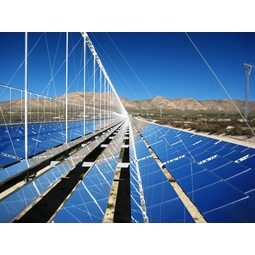The owners of the Collinsville coal fired power station in northern Queensland are planning to close and replace the ageing 180MW station with a “clean energy park” that will the see a combination of a solar PV array, a solar thermal installation, and a gas-fired booster – all combined to deliver 50MW of baseload power.
The fine details of the plan were revealed today by the power station’s owner, Ratch Australia. RenewEconomy had previously revealed plans for a solar PV array, and it now turns out that this will be a 20MW solar farm, with a 30MW solar thermal installation using linear fresnel technology owned by Novatec Solar, majority owned by Australia’s Transfield Services.
Ratch also wants to install a gas-fired turbine – either a new one or a re-commissioned one from the existing Collinsville station, to provide flexibility and back-up, and to deliver what development manager Anil Nangia described as 50MW of “baseload power.” He said using gas would be cheaper than current options for solar thermal storage.
The plans will mark quite a transformation for the Collinsville plant, which was once bought for a single dollar by Transfield, upgraded and recommissioned, and which had been put forward for a 150MW solar thermal plant under the now defunct Solar Flagships program.
The money from the Solar Flagships is now being managed by the Australian Renewable Energy Agency, and it has awarded $2.5 million to Ratch under its Emerging Renewables Program to investigate to what extent old coal-fired turbines can be re-purposed for solar hybrid installations.
Nangia said the study would take nearly two years, but the company would go ahead with planning approvals in the meantime. It hoped to reach financial close on a solar thermal hybrid project – with a new or repurposed turbine – in February 2015. By that time, it hoped to have the 20MW solar PV plant either completed or well under construction. It would operate the PV plant on its own until the solar thermal hybrid component was completed.
Federal Resources and Energy Minister Martin Ferguson, in announcing the grant, said the knowledge gained through the study will help accelerate the deployment of concentrating solar thermal in Australia through hybrid projects, which he said would help overcome the challenges of early deployment of concentrating solar thermal.
“Such information will include the overall technical feasibility of converting thermal coal fired power stations to solar thermal plants, its costs, the solar yield, network connection and other issues,” Ferguson said in a statement.
Nangia said Ratch had set aside two separate areas for the PV and solar thermal components. Both would take advantage of the connections that already existed at the site.
He said when a pre-feasibility study was completed 12 months ago, the cost of solar PV and solar thermal was about equal, but solar PV costs had fallen dramatically since then, and were now around $120-$150/MWh.
He said Ratch hoped to deliver the solar thermal component at under $200/MWH, which would still be a significant cost reduction.
“This study is going to help us understand whether it is worthwhile to use an old coal plant (for solar),” he told RenewEconomy.
Ferguson also announced three other solar research projects, including:
– a study by Ipsos Social Research Institute into the social licence to operate for utility-scale solar installations, which will receive $153,388 to investigate levels of community awareness and attitudes towards large-scale solar installations.
– A study by the Monica Oliphant research institute into funding models for community-owned solar projects. The study receives $15,000 to investigate how renters, low income earners, or those who live in houses that aren’t suitable for solar photovoltaic panels to be involved in renewable energy projects..
– a study into the System Advisor Model (SAM) for Australian Concentrating Solar Power (CSP) stakeholders by the Australian Solar Thermal Energy Association to work with the National Renewable Energy Laboratory to modify its model to suit the project economics of Australian market conditions.










